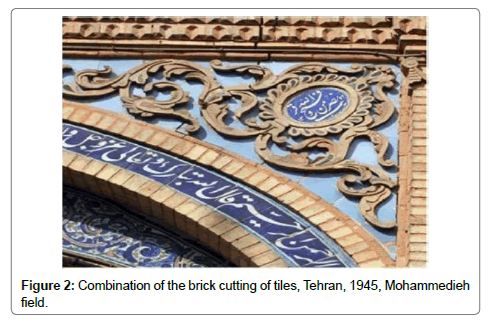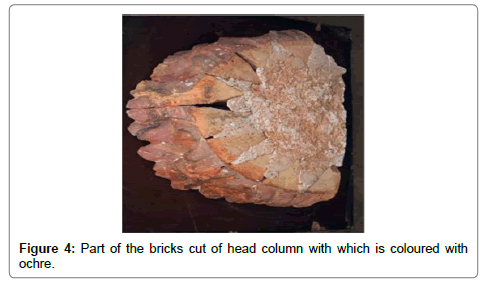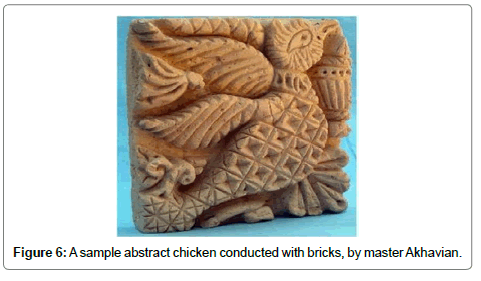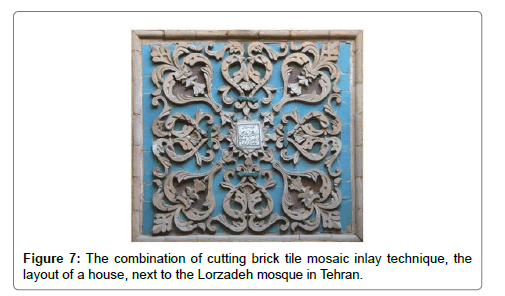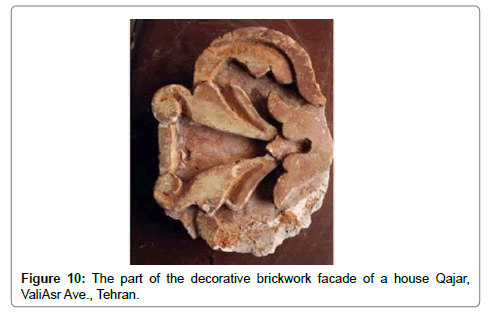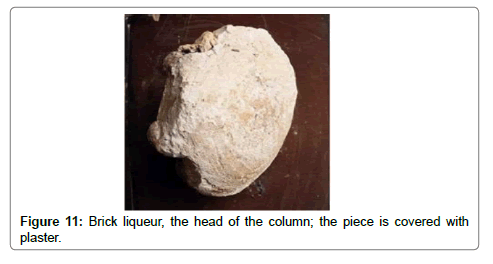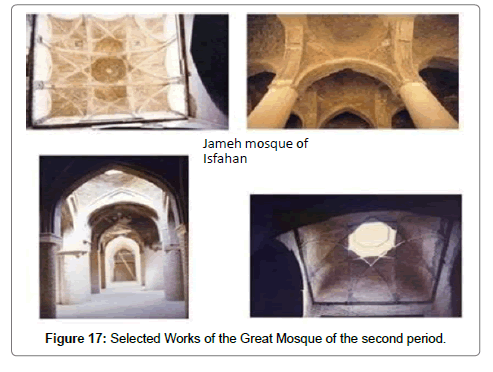Research Article Open Access
Studying the Brickwork of Islamic Mosques as Architectural Decorations
Seyed Hadi Ghoddousifar1 and Davoud Zarean MS2*1Department of Architecture, Islamic Azad University, Sout Tehran Branch, Tehran, Iran
2Department of Architecture, Islamic Azad University, International Branch, Kish, Iran
- *Corresponding Author:
- Davoud Zarean MS
Department of Architecture
Islamic Azad University, International Branch
Kish, Iran
Tel: + 98 21 22 58 28 34
E-mail: dz_arch@yahoo.com
Received Date: April 10, 2017; Accepted Date: April 20, 2017; Published Date: April 30, 2017
Citation: Ghoddousifar SH, Davoud Zarean MS (2017) Studying the Brickwork of Islamic Mosques as Architectural Decorations. J Archit Eng Tech 6: 193. doi: 10.4172/2168-9717.1000193
Copyright: © 2017 Ghoddousifar SH, et al. This is an open-access article distributed under the terms of the Creative Commons Attribution License, which permits unrestricted use, distribution, and reproduction in any medium, provided the original author and source are credited.
Visit for more related articles at Journal of Architectural Engineering Technology
Abstract
Bricks are local materials and efficient architecture in Iran. Bricks are used in buildings and for decoration. Brickwork is one of the ways of decoration in architecture which is done with simple and sharp tools. Brickwork of Iranian architecture was used in the Achaemenian period and it flourished and its decorative applications reached its peak in the Islamic period, especially in mosques of the Seljuk period. The mosque has been raised in the early days of Islam as a center of idea exchanges and a place of reflection, so that the prevailing architecture came into existence, based on the ideas and social views in the Islamic world. At the beginning, the exterior architecture looked very simple and its exterior was not very distinct from other architectures. But with the passage of time and the arrival of mosques in Iran, Iranian architectures’ ideas were inspired by the Islamic world and the mosque had a great impact on the sub-structure, and a diverse array of elements were added to it and adapted with Iranian and Islamic philosophy, which identifying these elements are among factors discussed and analyzed in these structures. This kind of decoration, continued until the beginning of the second Pahlavi period and then with the mainstream use of cement, iron, aluminium and new materials, the use of bricks was reduced and the art of brickwork declined. Studying the different species of brickwork and its relationship with its decorative features and applications, can be effective in its rehabilitation and re-prosperity.
Keywords
Decorations; Islamic architecture; Mosques; Brickwork; Brickwork era; Iran after Islam
Introduction
Bricks are one of the oldest construction materials used in building and construction and in decorating buildings. "Brick is a Babylonian word. It was the name of the written clays which commands, charters and other writings are written on them." The openings were without form and shape and were irregular bricks, but the bricks began to wear off on a regular basis and were produced as one size. Archaeologists estimate the age of the brick as ten thousand years. In the West of Iran such as "Hasanlu hill," raw moulds are used, and from about the fourth millennium BC in the central plateau of Iran, the region, "Silk Kashan", the remains of brick kilns have been found [1].
In general, the brick industry was evolved in the architecture before the Achaemenid era; As far as in the Achaemenid period, baking painted and glazed enamelled bricks were very common. The Buildings of "Zanbil ziggurat" in Susa, "Arch deficit" in Ctesiphon, the Sassanian Yaytkht, large arches "Firozabad Palace» Fars, buildings and the "Hanging Gardens of Babylon" in Iraq, are worth noting before the Islamic era brick buildings that in terms of technical and artistic. In different periods, the size and shape of the bricks changed. Square and rectangular bricks were most widely used in architecture. The brick size, the width and the length, width and thickness, gradually became smaller. The Twin Towers of "Khorqan" and "Amir Ismail Samani" tomb are a masterpiece of brickwork. Also the earth domes and columns of Isfahan Mosque are a mixture of art, geometry and technique. "Rabat" Caravanserai was named as the Brick Museum and a variety of towers and spiers and desires, such as "Mehmandust" Tower in Damghan, "Aladdin" Tower in Varamin, the "Radkan ' shaft in Khorasan are the Islamic era brick buildings which are very important. In this building, various methods brickwork and brick pickle is used. Strength, hardness, colour, size variation, easy production, the availability of raw materials, the preparation, staining glaze colors of minerals, tension and action, insulation against heat and cold, easy installation and compatible with other materials such as tile, brick, stone and plaster of benefits that make them widely used in Iranian architecture. According to "Simon Aivazian," the Iranian brick architecture is not only a speck in the grand architecture, but is modular in architecture, which sits at the heart and core and has a decisive role. Brick in the building is like a note in music, or is as a word in poetry.
Bricks can be used in all spaces and architectural elements such as walls, ceilings, floors and inside buildings, covering dome, desire, and minarets. As mentioned, one of the features of bricks is its verification for cutting. It has a long history. To make bricks come in various forms, cutting must be needed. In the second half of Qajar and early Pahlavi period, first by using this technology, buildings’ view and in particular, facades were decorated [2]. In addition, executive techniques and various applications of Brick associated with some of the previous samples are conducted.
Historical background
Brickwork techniques flourished in pre-Islamic period of Achaemenid palaces and it is believed that glazed reliefs of Apadana and Susa are implemented in the same way; meaning that the simple and pattern less bricks are cooked in the grill, and then cutting them like a stone reliefs, reliefs, which often consisted of a double row of soldiers or animals like griffins, are conducted protuberantly and at the end are enamelled. Pre Islam Brickwork was quite popular from the Seljuk period and is one of the most important applications in the inscriptions [3]. For doing the inscription, it was necessary for the brick to be polished and cut, so that the words are conducted in it (Figure 1).
To soften the edges, filling the corners and connect several different levels, or to run the geometric and herbal designs, it was necessary to cut the bricks. The technical requirements with artistic aspect of architecture required that architects and artists to dispel some problems with shaving bricks organize their work. Cutting bricks, the ability to run different compositions to provide a variety of projects and roles for architects made materials. After the Seljuk period began with the advent of plaster and tiles in the architecture accessories Decorations tiling, decorative use of brick less, until the procedure again in the Qajar period, because of the importance of outer space for diverse and different than in the past, were used to decorate. Masonry brick in the building was used especially in the entrance of vegetable and row houses with roles and projects Mogharnas train layout. Brickwork thrived very much in most Iranian cities including Tehran, Tabriz, Shiraz, Dezful, which the city is famous for Bricks. In Dezful, in addition to Chinese bricks, there is another type of brickwork called nodes or brick-cutting task, which is based on various designs brick shape by the axe. Such decorations continued until the end of the first Pahlavi period and the introduction of modern architecture, color and face became transformed cities and houses and other materials such as cement, iron and stone were replaced by brick. Due to lack of qualified teachers in this field and not familiar with these ornaments architects and designers, as well as being difficult and time-consuming cutting brick, and the need to speed up the construction of new buildings and on the other hand, tends to West architecture and attitude suited to the Qajar architecture, it has caused to diminish and it should not be used in the new architecture (Figure 2) [4].
The definition of brickwork
Shaving a part of the brick with different tools, to create geometric and plant designs on your body and brick roles is called brickwork. The jobs of those who cut bricks with axes are called the axe handler. Shaving can be placed on one or more square or rectangular brick, which undergo and together make up the final shape of the plan [5]. Projects and roles can be a variety of materials such as brickwork, tile, stone, plaster and bricks seal and moulding compounds (Figure 2). Brick cuts can be painted with water colors. Shades of blue, ochre (red) and yellow (Glmashy) which are More used (Figures 3 and 4).
Sometimes the cutting of bricks may be performed before the baking. These types of bricks are called pre-cut bricks. In other words, these bricks were heated and then cut to the desired size and shape. The bricks have limitations in design, and implemented projects with such simple forms and geometric more brick and repetitive, so that the possibility of making the surface of the brick brickwork is different [6].
Tools and material
The first thing which is necessary for brick work is a desirable and durable brick. Bricks must be soft and crisp, the texture and density of light is not compressed, so that you can easily cut and scratch the surface of the brick. Porous texture brick causes the cutting edges to bake bricks. Impurities in the body of brick, plan to damage the detailed implementation. For cutting bricks, a few simple tools, such as File flat, round and half round rasp, chisel and hammer, metal compass saws, sharp metal gouges and some other simple tools are used that are usually based on the type of work they provide for cutting bricks [7].
Method
The brick work method depends on the type of work and its imagery. If the design of plant designs (arabesques Yakhtayy) and the curved line images are used, the procedure is somewhat like the wood inlaid or mosaic tiles. In this way the project can be implemented on a brick, like some master works of Akhavian in Neyshabur (Figures 5 and 6).
Photos by Mehdi Akhavian and can be a great plan executed on a couple of bricks. To do this, first bricks lay on a flat surface, as well as the real one together with the thistle, then designed with pencils or other means, and transferred to the brick body. Moving parts are below or next to each piece numbered based on these numbers, we can again put all the pieces together. After Marking, bricks are cut. If the field work, plaster, tiles, etc., you must first empty brick ground level, such as lattice or mosaic tiles to fill the void with (Figure 7).
It is possible for field work to be used from simple building blocks, such as canvas. But sometimes it means that first negative level designs should be carved. If the designs have volume, depressions and protrusions are made with more delicate tools [3]. In areas such as the entrance or gate house, which a variety of cut bricks are used, the different parts such as columns, headers, high train layout, etc. are separately carved and then installed in their place (Figures 8 and 9).
To avoid disorganization of parts, multiple units together would be easier to install with plaster to form fabric (Figures 10 and 11).
The mode of implementation of geometric patterns is different: Because usually a unit or a module is repeated, the repeat unit is important and the sizes should be carefully calculated; For a repetitive arrangement of geometric designs in each unit repeats, even if a slight error is present, the amount of error in each iteration doubles, so that, for example, in the tenth iteration, there has been a tenfold error. Geometric designs have been conducted as flat or with volume. To run a geometric design, length and width must be measured, to calculate and determine the desired shape which is repeated several times. After this calculation, the repeating units are separately prepared and finally the work is put together. In primitives, and nodes in corners, you have to run for a second or a quarter; otherwise the form is incomplete [8]. The figure below shows the ability of the brick; Outstanding amounts of light to create shadow, sharp levels of contrast between warm colour and geometric brick half-circles with cyan, has added to its appeal (Figure 12).
Applications
Cutting bricks have diverse applications in architecture. According to the ductility of the brick, it can be used to decorate the inside or outside of these types of bricks. But it is most widely used for cutting brick facades, for columns, half-columns, headers, different levels on walls, siding, framing windows, shelves, brick lattice windows, inscriptions, pots and other parts of the building to be used properly (Figures 13-15).
Different Periods of Brickwork in Pre-Islamic Iran
Due to a shortage of wood and there are termites in central Iran, which makes it possible to minimize the use of wood, as well as high heat exchanging stones, which are not of much use in hot and cold climates, and due to variations in climate in Iran, Brick opened its place in the country and was widely spread throughout Iran. After Islam, Iran Architecture continues with its previous architecture which grew and flourished, and the long history of brick was the world's most beautiful architectural works of Iranian architecture and created in different historical periods. Doctor Parviz Varjavand in a comprehensive article, "brickwork architecture of the Islamic period", divided brickwork in different historical periods of Islam into approximately five periods. Then he pointed out that the features and characteristics of each period, does not mean that all buildings with brick facing, have those characteristics. Not to mention more than a few highlights of the valid period, and pointed out that, in each period during the previous practice wasn’t changed at once. In the following, we briefly mention the five kind periods.
The first period of the second century to the early fifth century (Samany-Ghaznavi-al-Ziarat and Buyids)
Characteristics of the First Age, harmony and unity among the decorations and the whole building, like Gonbad-e Qabus, towers Lajim and Rsgt in Savadkuh, Western Radkan rod and eastern Pir Alamdar Damghan, Iran, Afghanistan Khorasan tahini northern and central Iran is on. He used that period, as during the formation and evolution has learned. In the mentioned buildings, bricks are simply used in the building, and in the middle or top of the brick building with the inscription, sometimes with Kufic and sometimes faced with the return line side, which were adorned with skill and beauty is unspeakable, how bricklayer in Gonbad-e Qabus, Lajim tower and eat Western Radekan and Pyrlmdar, the whip and the body is so simple and almost without ornament of great simplicity and elegance. The first map is starlike and the rest of the map is like a circle (Figure 16) [9].
The second period from the beginning of the fifth century to half of the seventh century (the Seljuks and Kharazmshahian)
The second period include Seljuk era until the Mongol invasion, which art brickwork is widespread across the Iranian plateau. Economic and political conditions would be created at this time, magnificent buildings to be built across Iran, the art of brickwork every day, role and create a new plan, so that in the above article, this period is called the era of expansion and evolution of the art of brickwork and reads:
"It's all power in space, with a hard and lifeless matter and a brick colour, the art of creating art of masonry virtues that we created it in the Seljuk era and the patriarch of this place (Mosque of Isfahan) are viewed. The minarets of the era, whether they are in the land of Khorasan skyrocketed under the azure of completed and whether they are tall, All are worthy of samples brickwork art in this era ". Kharraqan towers of Qazvin, Isfahan Mosque, Rabat, Minarets of Isfahan and Khorasan and Red Dome Maragheh are typical buildings of this era [2]. Brick decorations, which in the previous period was limited to only one justify text, in this period is extended, and achieves varied and beautiful forms. Holy Names like Muhammad Ali, Muhammad repeated and combined, and the upper edge of the building and the roof is transmitted to the body. Decorative brick in this period peaked and diverse projects are created in this period, and it seems that there is no other plan to offer to its fullest extent brickwork is reached (Figure 17) [3].
The third period since the mid-seventh century to the tenth century (Ilkhan and Timurid and al-Muzaffar)
In these periods, Ilkhan, Timurid and al-Muzaffar, bricks absolutely lost their sovereignty. It appeared perhaps for that reason to be no plan and there is a new design to add to the repertoire of Seljuk. Elemental tile and brick composition, and in some cases, stone and brick are used instead. During this period, after the construction of the building, outer coverings are made by bricks. The highlights of this period were the mosque and the tomb of Maulana Zinedine Ababkr in Taybad and dome Mosque of Yazd and Nasir-ul-Haq and Shams Tabarsi in Amol and Darvish Fakhr al-Din in Babol. The combination of brick and tile, to the designers and architects of the period allowed the use of colour, more prominent roles brick and quench to showcase and highlight instead of bricks (or gone dormant and Tepgin), the colour used (Figure 18) [10].
The fourth period since the beginning of the tenth century to the twelfth century of the Safavid period
Scraping and water Sub-offing a brick was characterized by the Safavid dynasty, but at this time, because of paying too much attention to the tile, brick importance is reduced, and decorative tiles are exponentially more for public buildings. In this era of lack of attention to this beautiful material, flexible and inexpensive causes which, in the next period, the Qajar period, using another brick in continuity with the glorious past and face brickwork in Iran appear quite alien [11].
Fifth period of the twelfth century to the end of the thirteenth century of the Zandieh and Ghajar era
In the Qajar era, vertical bands will be removed and stuck together and brickwork bricks from the width of the frame around the levels of clay tiles are decreased, and reaches its peak in brick facades for decorative moulding and cutting the bricks, which the bricks are in various shapes and sizes, geometric and non-geometric. Brickwork in residential buildings in the historical texture of our cities, mostly belong to the fifth period. It is interesting to note that, in this era, brick work existed throughout the country, with similar characteristics, but also achieved significant variation in different parts, and although it seems that the era of brick was gone in southern regions of Iran, faced with a phenomenon that will soon amaze us [12].
Symbolism in Architecture
Individuals will be able to improve their personal position through symbolism and achieve a social and targeted life. Every human product can be a symbol or a tool, which serves the purpose of the order (mean) up to certain ratios between human and his environment and non-linguistic behaviour as much as language depends on structured symbolic systems. The purpose of symbolism is making the man to break through the boundaries within the society and the world and his integration with the rhythm of nature. Locations are purposes or centres in which we find significant events of our existence but locations are also the starting points through which we find our direction and feel a sense of belonging to the environment. In the meantime, architecture is a symbolic system which expresses the character and spatial relationships that creates a whole: "human environment" [10-14].
Conclusion
Brick, the oldest materials used in Iranian architecture, was considered three thousand years ago by Persian architecture, and using these materials as much as creating architectural masterpieces, whether on earth or in the area of structure and physical appearance and decorations to cover roofs and vault Beautiful views, advanced to the point that has apparently no longer anything new to say, and since then, the combination of brick and tile to diversify, and after achieving the tiles and identify possible that, in establishing the role and form the facade turned into tiles, and tiles are replaced by bricks and also has the materials utmost beauty and perfection, and then declined over the brick and tile mosaic tile is used instead, and then, overcome bricks and tiles, both as the only materials that were used in decoration of facades, are almost excluded, and at the time of Modernism and the late Qajar, Mehri brick in Tehran is particularly prevalent, such as adobe tiles in the middle of the Safavids, and then, to achieve the intricate adornments and plant flowers and angels and crown and had come from abroad, has turned into plaster decorations [2].
In view of brick decorations, buildings in other towns were less prone to this injury. Shushtar and Dezful, have the last statement on brick work, and then, the other at any point of the country, rather than any architecture that can bring justice to the unique features of the materials most widely used in decoration of facades, was not seen, and has no effect on the extent of creation, which is not the last word in brickwork for decorating buildings, which unfortunately every corner of it is destroyed [9,15-18]. The use of brick in the decoration of architecture, in addition to beauty, builds the Iranian character; Provided that the architects of executive skills and capabilities be aware of this matter and with new features, and today offer innovative projects, are inspired by outstanding examples of the past. Brickwork ways of the past, which relied more on manpower and hands, today, thanks to equipment, devices and tools can be efficiently utilized, and this artistic discipline has been abolished in the construction of architectural decorations will be re-propertied . Architectural elements such as the altar in mosques, domes and minarets, etc., the same arena for symbolic expression, belief, faith and Muslim culture provided and on the other hand, the expression of Arabesque decorative motifs, geometric form the foundations of this sacred place to build more robust. On the other hand, the decorations, rich and rich in colours and forms in religious places such as mosques, shrines and tomb and schools in Muslim lands gave an identity to them [19,20]. By studying the origin of the motifs on the one hand, it makes us familiar with our beliefs, culture and social and religious customs of the people with the territory and on the other hand, provides a conscious and continuous use of land to this array of contemporary architecture.
References
- Karim PM (1995) Islamic architecture.Edited by GholamhosseinMemarian, University of Science and Technology, Tehran.
- Nasr T (2007) The art and Islamic art. Publishing Navid, Shiraz.
- Karim PM (2001) Stylistics of Iranian architecture. Edited by GholamHosseinMemarian, publishing inquiring architect, Tehran.
- Arthur P (2003) Architecture of Iran. Translated by GholamHossein Sadri Afshar, Akhtaran publishing, Tehran.
- Memarian GH (2005) Siri on the theoretical foundations of architecture. Knowledge Soroush Publications, Tehran.
- Mohammadi HJA (1993) Author and designer. Tehran, in cooperation with the Cultural Research Bureau in Tehran.
- Ghirshman R (1994) Zanbil. The translation of the first volume by AsgharKarimi, Cultural Heritage Organization.
- Andre G, Maxim C (1987) Iran effect. Translation by HasanSarvghadi, Islamic Research Foundation of Astan Quds Razavi, Mashhad.
- Far FS (2000) Glossary of traditional Iranian architecture. Kamyab publishing, first print.
- Donald W (1967) Islamic Architecture Volume patriarch.Translation by Abdullah Faryar, firm Translation and Publication, Tehran.
- Joseph K (1997) The Islamic era of architectural ornaments. Cultural Heritage Organization publications, Tehran.
- Memarian GH (2008) Iranian architecture, knowledge Soroush Publications, Tehran.
- Etinghousen A, Graber RO (1999)Islamic art and architecture.Jacob Azhand, the study and development of Humanities’ Books (post), Tehran.
- Pour AG (2001)The beauty of worship in Islamic mysticism.Tahoori Publications, Tehran.
- Ayatollah H (2001) Book of Iran. Publications International Mahdi Tehran.
- Pope AU (1986) Architect of the triumph of form and colour.Translation by KeramatallahAfsar, Yasavali publications (cultural center), Tehran.
- Joseph K (2000) Iran Islamic architecture.Publishing organization and ICTS study of Social Sciences, Tehran, Iran.
- Proceedings of the Second Congress of Mosque Architecture (2001) University of Art, Tehran.
- Nasr T,SaqapourH (2009)Contemporarytypologyofthemosque. Shiraz (architectural elements and arrays), research projects, Islamic Azad University of Shiraz.
- HillenbrandR (2000)Islamic architecture form, function and meaning.Translation by I. Etesam, processing and urban planning, Tehran.
Relevant Topics
- Architect
- Architectural Drawing
- Architectural Engineering
- Building design
- Building Information Modeling (BIM)
- Concrete
- Construction
- Construction Engineering
- Construction Estimating Software
- Engineering Drawing
- Fabric Formwork
- Interior Design
- Interior Designing
- Landscape Architecture
- Smart Buildings
- Sociology of Architecture
- Structural Analysis
- Sustainable Design
- Urban Design
- Urban Planner
Recommended Journals
Article Tools
Article Usage
- Total views: 10158
- [From(publication date):
April-2017 - Aug 24, 2025] - Breakdown by view type
- HTML page views : 8970
- PDF downloads : 1188


